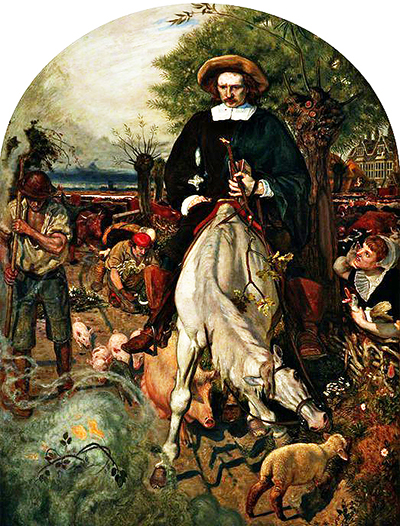Perhaps one of Ford Madox Brown's more allegorical paintings, this image is packed with symbolism and hindsight.
At first glance, Cromwell on His Farm seems to be a simple pastoral scene: Cromwell, as wealthy landowner, sits high above his lowly workers – a farmhand who keeps his eyes cast down on his work, while others, in the background, are literally grubbing in the dirt, occupied in some nameless task. To Cromwell's left (the right side of the picture) a maid is trying to get his attention, amusingly echoed by the duck she is clutching. She is trying in vain, however, Cromwell's full attention seems to be fixed on the small bonfire in front of him, even as his horse snatches the opportunity to steal a mouthful of grass while he is thus distracted.
However, the painting is much more than an amusing (if somewhat patronising) tableau of farm life. Cromwell is being urged to action, by the woman and the duck – perhaps a statement that both mankind and nature are crying out for change, urging those who are able to do something about the status quo to take the opportunity: even if it means leaving behind those who cannot or will be stirred into action. The temptation to inertia is one commonly felt when a situation is moving from acceptable to unbearable, and this painting seems to have captured the moment of pivot: the point of no return has been reached, and yet – as yet – nothing has been done about it. But it will.
That this course of action plunged the United Kingdom into a bloody Civil War and saw the deaths of hundred of patriots is not foreshadowed – all we see is that Cromwell is seeing the impetus to change and will shortly be moved to take action: everything hangs in the balance. Cromwell seems well aware of the seriousness of what he is considering. His face is deeply thoughtful, almost entranced, as he, perhaps, plays out all the many ways history will see him: villain, saviour, traitor, patriot – as in fact it did, all of the above: variously at one time or another.
What Madox Brown felt about Cromwell is not clearly stated in the image, and he is perhaps trying to see both sides of the story. Cromwell was, in part, driven by deeply held religious beliefs, and this is shown in the fall of his sleeve which takes the shape of a crucifix, while the book held, one finger marking his place, in one hand, could easily be a bible. A moment and an allegory both, a moment in time which called Cromwell inexorably into action that would change his world forever. The painting, in oil on canvas, is large, measuring 143 by 104.3 centimetres, and can be seen in the Lady Lever Art Gallery near Liverpool in the United Kingdom.




